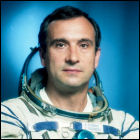 The cosmonaut who still holds the record for the longest single stay in space, Dr. Valery Polyakov, dies at the age of 80. Born in 1942, Polyakov joined the cosmonaut corps in 1972, and then had to wait sixteen years for his first flight, aboard Soyuz TM-6 to the Mir space station in 1988, where he stayed for 240 days. In January 1994 he returned to Mir aboard the Soyuz TM-18 mission, and remained in orbit for a continuous 437 day stay, still the longest continuous spaceflight undertaken by a human being at the time of his death. He returned to Earth in March 1995 and retired from the active cosmonaut rotation a few months later, remaining with the post-Soviet Russian space program as an advisor in the area of the health effects of long-term spaceflight, as well as having a hand in selecting future cosmonauts. He was awarded both the Hero of the Soviet Union and the Hero of the Russian Federation over the course of his career. Though fellow cosmonaut Sergei Adveyev holds the record for the most time in space, that time was accumulated over the course of three missions; as of 2022, Polyakov’s single-flight record remains unbroken.
The cosmonaut who still holds the record for the longest single stay in space, Dr. Valery Polyakov, dies at the age of 80. Born in 1942, Polyakov joined the cosmonaut corps in 1972, and then had to wait sixteen years for his first flight, aboard Soyuz TM-6 to the Mir space station in 1988, where he stayed for 240 days. In January 1994 he returned to Mir aboard the Soyuz TM-18 mission, and remained in orbit for a continuous 437 day stay, still the longest continuous spaceflight undertaken by a human being at the time of his death. He returned to Earth in March 1995 and retired from the active cosmonaut rotation a few months later, remaining with the post-Soviet Russian space program as an advisor in the area of the health effects of long-term spaceflight, as well as having a hand in selecting future cosmonauts. He was awarded both the Hero of the Soviet Union and the Hero of the Russian Federation over the course of his career. Though fellow cosmonaut Sergei Adveyev holds the record for the most time in space, that time was accumulated over the course of three missions; as of 2022, Polyakov’s single-flight record remains unbroken.
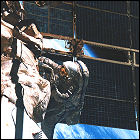 Russia launches the Soyuz TM-22 mission to space station Mir, carrying cosmonauts Yuri Gidzenko and Sergei Avdeyev from Russia, and Thomas Reiter from Germany. The three space travelers settle in for a 179-day stay aboard Mir, from which they will return early in 1996.
Russia launches the Soyuz TM-22 mission to space station Mir, carrying cosmonauts Yuri Gidzenko and Sergei Avdeyev from Russia, and Thomas Reiter from Germany. The three space travelers settle in for a 179-day stay aboard Mir, from which they will return early in 1996.
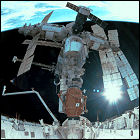 NASA launches Space Shuttle Atlantis on the 73rd shuttle flight, an eight-day mission to dock with Russian space station Mir. Due to the docking difficulties of the first flight – which required Mir crew members to move one of their station’s modules out of the shuttle’s way temporarily – Atlantis carries a Russian-made docking adapter which adds a tunnel to one of Mir’s docking ports, allowing the shuttle to join up with the station without further module relocation. Atlantis carries Commander Kenneth Cameron, Pilot James Halsell, and mission specialists Jerry Ross, William McArthur and Chris Hadfield to visit Mir; there is no crew exchange on this flight.
NASA launches Space Shuttle Atlantis on the 73rd shuttle flight, an eight-day mission to dock with Russian space station Mir. Due to the docking difficulties of the first flight – which required Mir crew members to move one of their station’s modules out of the shuttle’s way temporarily – Atlantis carries a Russian-made docking adapter which adds a tunnel to one of Mir’s docking ports, allowing the shuttle to join up with the station without further module relocation. Atlantis carries Commander Kenneth Cameron, Pilot James Halsell, and mission specialists Jerry Ross, William McArthur and Chris Hadfield to visit Mir; there is no crew exchange on this flight.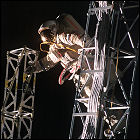 Russia launches the Soyuz TM-23 mission to the Mir space station. The crew, cosmonauts Yuri Onufrienko and Yury Usachov, remain aboard Mir for 193 days, returning to Earth in September 1996 with French spationaut Claudie André-Deshays.
Russia launches the Soyuz TM-23 mission to the Mir space station. The crew, cosmonauts Yuri Onufrienko and Yury Usachov, remain aboard Mir for 193 days, returning to Earth in September 1996 with French spationaut Claudie André-Deshays.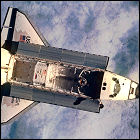 Space Shuttle Atlantis lifts off on the 76th shuttle mission, a flight to dock with the Russian space station Mir. Supplies are delivered to Mir by the Atlantis crew, and astronaut Shannon Lucid remains aboard Mir to join its Expedition 21 crew. Atlantis also carries the SPACEHAB module, where both the shuttle and station crews conduct joint scientific experiments. Aboard Atlantis for her 16th flight are Commander Kevin Chilton, Pilot Richard Searfoss, and mission specialists Shannon Lucid, Linda Godwin, Michael Clifford and Ronald Sega.
Space Shuttle Atlantis lifts off on the 76th shuttle mission, a flight to dock with the Russian space station Mir. Supplies are delivered to Mir by the Atlantis crew, and astronaut Shannon Lucid remains aboard Mir to join its Expedition 21 crew. Atlantis also carries the SPACEHAB module, where both the shuttle and station crews conduct joint scientific experiments. Aboard Atlantis for her 16th flight are Commander Kevin Chilton, Pilot Richard Searfoss, and mission specialists Shannon Lucid, Linda Godwin, Michael Clifford and Ronald Sega.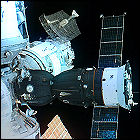 Soyuz TM-24 is launched from Russia, on a mission to dock with the Mir space station. Aboard are cosmonauts Valery Korzun and Aleksandr Kaleri, who stay aboard Mir for 196 days, and visiting French spationaut Claudie André-Deshays, the first French woman in space, who stays aboard Mir for 16 days before returning to Earth with the station’s previous crew aboard Soyuz TM-23. Korzun and Kaleri will return to Earth in March 1997.
Soyuz TM-24 is launched from Russia, on a mission to dock with the Mir space station. Aboard are cosmonauts Valery Korzun and Aleksandr Kaleri, who stay aboard Mir for 196 days, and visiting French spationaut Claudie André-Deshays, the first French woman in space, who stays aboard Mir for 16 days before returning to Earth with the station’s previous crew aboard Soyuz TM-23. Korzun and Kaleri will return to Earth in March 1997.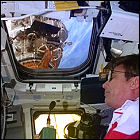 After multiple delays, including the entire launch stack having to be rolled back into the safety of the Vehicle Assembly Building to protect it from two back-to-back hurricanes, Space Shuttle Atlantis lifts off on the fourth mission to dock with the Russian Mir space station. Supplies are transferred to Mir, and numerous completed science experiments from Mir are loaded into the shuttle. Atlantis is flown by Commander William Readdy, Pilot Terrence Wilcutt, and mission specialists Thomas Akers, John Blaha, Jay Apt and Carl Walz. Blaha remains on Mir, taking the place of American astronaut Shannon Lucid, who has just set a new American space endurance record of 188 days in orbit; Lucid returns to Earth with the Atlantis crew.
After multiple delays, including the entire launch stack having to be rolled back into the safety of the Vehicle Assembly Building to protect it from two back-to-back hurricanes, Space Shuttle Atlantis lifts off on the fourth mission to dock with the Russian Mir space station. Supplies are transferred to Mir, and numerous completed science experiments from Mir are loaded into the shuttle. Atlantis is flown by Commander William Readdy, Pilot Terrence Wilcutt, and mission specialists Thomas Akers, John Blaha, Jay Apt and Carl Walz. Blaha remains on Mir, taking the place of American astronaut Shannon Lucid, who has just set a new American space endurance record of 188 days in orbit; Lucid returns to Earth with the Atlantis crew.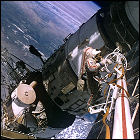 Russian cosmonauts Vasili Tsibliyev and Aleksandr Lazutkin lift off aboard Soyuz TM-25 for an eventful mission aboard Russian space station Mir. Tagging along is German space traveler Reinhold Ewald, who will remain in space for 19 days before returning to Earth with Mir’s previous crew aboard Soyuz TM-24; Tsibliyev and Lazutkin will later be joined by American shuttle astronaut Jerry Linenger. Their 184-day stay is marred by numerous emergencies aboard the station, ranging from a fire in the station’s cramped quarters to a collision with an unmanned Progress cargo spacecraft, which Russian ground controllers are initially eager to keep quiet from the rest of the world.
Russian cosmonauts Vasili Tsibliyev and Aleksandr Lazutkin lift off aboard Soyuz TM-25 for an eventful mission aboard Russian space station Mir. Tagging along is German space traveler Reinhold Ewald, who will remain in space for 19 days before returning to Earth with Mir’s previous crew aboard Soyuz TM-24; Tsibliyev and Lazutkin will later be joined by American shuttle astronaut Jerry Linenger. Their 184-day stay is marred by numerous emergencies aboard the station, ranging from a fire in the station’s cramped quarters to a collision with an unmanned Progress cargo spacecraft, which Russian ground controllers are initially eager to keep quiet from the rest of the world.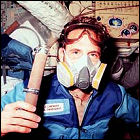 Fire breaks out aboard the Russian space station Mir, forcing the crew to break out face masks and goggles which they must keep on even after the fire is put out. The culprit is determined to be an oxygen generator, which is damaged beyond repair; fortunately, American crewmember Jerry Linenger is a medical doctor and determines that he and his crewmates are none the worse for wear. A new oxygen generator will arrive on the next Space Shuttle mission to Mir later in the year.
Fire breaks out aboard the Russian space station Mir, forcing the crew to break out face masks and goggles which they must keep on even after the fire is put out. The culprit is determined to be an oxygen generator, which is damaged beyond repair; fortunately, American crewmember Jerry Linenger is a medical doctor and determines that he and his crewmates are none the worse for wear. A new oxygen generator will arrive on the next Space Shuttle mission to Mir later in the year.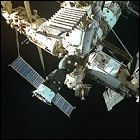 Crew members of space station Mir and Russian ground controllers practice manual remote control of an unmanned Progress supply vehicle near the station. Where most previous Progress spacecraft have automatically docked using the KURS radar system, Russia is now seeking alternatives, as the Ukraine-made KURS hardware is proving too expensive to keep buying for non-reusable vehicles. During Mir Commander Vasily Tsibliev’s attempt to redock Progress M33, the remote control signal is interrupted, leaving the ten-ton Progress barreling toward the station. Fortunately, it narrowly misses Mir, though the remote control issue will resurface more dramatically with the next Progress craft to visit the space station.
Crew members of space station Mir and Russian ground controllers practice manual remote control of an unmanned Progress supply vehicle near the station. Where most previous Progress spacecraft have automatically docked using the KURS radar system, Russia is now seeking alternatives, as the Ukraine-made KURS hardware is proving too expensive to keep buying for non-reusable vehicles. During Mir Commander Vasily Tsibliev’s attempt to redock Progress M33, the remote control signal is interrupted, leaving the ten-ton Progress barreling toward the station. Fortunately, it narrowly misses Mir, though the remote control issue will resurface more dramatically with the next Progress craft to visit the space station.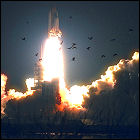 Space Shuttle Atlantis lifts off on the 84th shuttle mission, a ten-day flight with a visit to the Mir space station. Among the supplies hauled to Mir by Atlantis is a new oxygen generator to replace one damaged by a fire aboard the station in February. The crew for Atlantis’ 18th flight is Commander Charles Precourt, Pilot Eileen Collins, mission specialists Michael Foale, Carlos Noriega, Edward Lu, Jean-Francois Clervoy and cosmonaut Elena Kondakova. Foale remains to take up residence on Mir, while American astronaut Jerry Linenger leaves the station to return with the shuttle crew, having spent 132 days in space.
Space Shuttle Atlantis lifts off on the 84th shuttle mission, a ten-day flight with a visit to the Mir space station. Among the supplies hauled to Mir by Atlantis is a new oxygen generator to replace one damaged by a fire aboard the station in February. The crew for Atlantis’ 18th flight is Commander Charles Precourt, Pilot Eileen Collins, mission specialists Michael Foale, Carlos Noriega, Edward Lu, Jean-Francois Clervoy and cosmonaut Elena Kondakova. Foale remains to take up residence on Mir, while American astronaut Jerry Linenger leaves the station to return with the shuttle crew, having spent 132 days in space.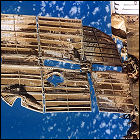 During an attempt to manually redock a Progress unmanned supply capsule via remote control from space station Mir, Mir Commander Vasily Tsibliev misjudges Progress’ speed and distance, and the vehicle collides with the station’s Spektr module, breaching that module’s outer skin and allowing decompression to begin. As the hatch to that compartment is sealed off to save the rest of the station (and the crew’s lives), Mir begins tumbling in its orbit, losing power (and all contact with Earth) as its solar panels lose orientation to the sun. With only fleeting opportunities to contact ground controllers, the station’s crew of three has to use the thrusters of the Soyuz vehicle docked at Mir to realign the station and begin receiving solar power again, a process which takes 30 hours; they are unable to use the station’s rest room facility for over 48 hours due to the power loss. The Spektr module is never repaired and it remains sealed off for the remainder of Mir’s time in orbit; makeshift rewiring ensures that the solar panels not damaged in the collision return to service. Most of astronaut Michael Foale’s personal items and experiment data, stored in Spektr, are lost.
During an attempt to manually redock a Progress unmanned supply capsule via remote control from space station Mir, Mir Commander Vasily Tsibliev misjudges Progress’ speed and distance, and the vehicle collides with the station’s Spektr module, breaching that module’s outer skin and allowing decompression to begin. As the hatch to that compartment is sealed off to save the rest of the station (and the crew’s lives), Mir begins tumbling in its orbit, losing power (and all contact with Earth) as its solar panels lose orientation to the sun. With only fleeting opportunities to contact ground controllers, the station’s crew of three has to use the thrusters of the Soyuz vehicle docked at Mir to realign the station and begin receiving solar power again, a process which takes 30 hours; they are unable to use the station’s rest room facility for over 48 hours due to the power loss. The Spektr module is never repaired and it remains sealed off for the remainder of Mir’s time in orbit; makeshift rewiring ensures that the solar panels not damaged in the collision return to service. Most of astronaut Michael Foale’s personal items and experiment data, stored in Spektr, are lost.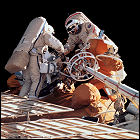 Russia launches Soyuz TM-26 on a mission to the Mir space station, which suffered numerous major malfunctions and damage during its previous crew’s stay. Aboard the Soyuz are specially selected cosmonauts Anatoly Solovyev and Pavel Vinogradov, who have trained on the ground to inspect and repair the damage to the station, though they are unable to find the hull damage to the now-abandoned Spektr module which threatened to cause total decompression of the station. They do manage to restore most of Mir’s solar power generating capability during their 197-day stay, returning to Earth in February 1998 with French spationaut Léopold Eyharts.
Russia launches Soyuz TM-26 on a mission to the Mir space station, which suffered numerous major malfunctions and damage during its previous crew’s stay. Aboard the Soyuz are specially selected cosmonauts Anatoly Solovyev and Pavel Vinogradov, who have trained on the ground to inspect and repair the damage to the station, though they are unable to find the hull damage to the now-abandoned Spektr module which threatened to cause total decompression of the station. They do manage to restore most of Mir’s solar power generating capability during their 197-day stay, returning to Earth in February 1998 with French spationaut Léopold Eyharts.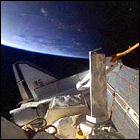 Space Shuttle Atlantis lifts off on an 11-day mission to dock with the Mir space station. In addition to routine supplies, replacement parts are brought to Mir to swap out with equipment damaged during the various incidents and accidents endured by Mir Expedition 23. The first-ever joint American/Russian spacewalk is conducted to undertake some of the repair activity and to try to find the location of the Spektr module hull breach. Aboard Atlantis for her 19th flight are Commander James Wetherbee, Pilot Michael Bloomfield, and mission specialists Vladimar Titov, Scott Parazynski, Jean-Loup Chretien, Wendy Lawrence and David Wolf. Wolf remains on Mir to join the Expedition 24 crew, while Mir crewmember Michael Foale returns to Earth aboard Atlantis, having served 145 unusually eventful days in space.
Space Shuttle Atlantis lifts off on an 11-day mission to dock with the Mir space station. In addition to routine supplies, replacement parts are brought to Mir to swap out with equipment damaged during the various incidents and accidents endured by Mir Expedition 23. The first-ever joint American/Russian spacewalk is conducted to undertake some of the repair activity and to try to find the location of the Spektr module hull breach. Aboard Atlantis for her 19th flight are Commander James Wetherbee, Pilot Michael Bloomfield, and mission specialists Vladimar Titov, Scott Parazynski, Jean-Loup Chretien, Wendy Lawrence and David Wolf. Wolf remains on Mir to join the Expedition 24 crew, while Mir crewmember Michael Foale returns to Earth aboard Atlantis, having served 145 unusually eventful days in space.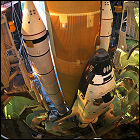 Space Shuttle Endeavour is launched on a nine-day mission to dock with the Russian Mir space station. Routine resupply activities are carried out, along with crew rotations. Endeavour’s crew for her 12th flight consists of Commander Terrence Wilcutt, Pilot Joe Edwards, Payload Commander Bonnie Dunbar, and mission specialists Michael Anderson, James Reilly, Salizhan Sharipov and Andrew Thomas. Thomas remains on Mir, while David Wolf returns to Earth aboard Endeavour.
Space Shuttle Endeavour is launched on a nine-day mission to dock with the Russian Mir space station. Routine resupply activities are carried out, along with crew rotations. Endeavour’s crew for her 12th flight consists of Commander Terrence Wilcutt, Pilot Joe Edwards, Payload Commander Bonnie Dunbar, and mission specialists Michael Anderson, James Reilly, Salizhan Sharipov and Andrew Thomas. Thomas remains on Mir, while David Wolf returns to Earth aboard Endeavour.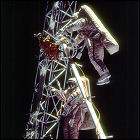 Russia launches the Soyuz TM-27 spacecraft on a mission to the Mir space station. Aboard are cosmonauts Talgat Musabayev and Nikolai Budarin; French spationaut Léopold Eyharts joins them for a 20-day before he returns to Earth with Mir’s previous crew. Musabayev and Budarin remain in orbit on Mir for 207 days, returning to Earth in August 1998 with cosmonaut Yuri Baturin. During their stay, further repairs were conducted to Mir’s solar power panels, which were damaged in a 1997 collision with a Progress unmanned cargo vehicle.
Russia launches the Soyuz TM-27 spacecraft on a mission to the Mir space station. Aboard are cosmonauts Talgat Musabayev and Nikolai Budarin; French spationaut Léopold Eyharts joins them for a 20-day before he returns to Earth with Mir’s previous crew. Musabayev and Budarin remain in orbit on Mir for 207 days, returning to Earth in August 1998 with cosmonaut Yuri Baturin. During their stay, further repairs were conducted to Mir’s solar power panels, which were damaged in a 1997 collision with a Progress unmanned cargo vehicle.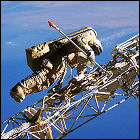 Russia launches Soyuz TM-28 on a mission to the Mir space station, with cosmonauts Gennady Padalka, Sergei Avdeyev and Yuri Baturin aboard. Padalka spends 198 days aboard Mir, conducting further repairs to the station damaged by a 1997 collision with a Progress cargo vehicle, while former politician Baturin remains aboard for 11 days before returning to Earth aboard Soyuz TM-27 with Mir’s previous crew. Avdeyev is aboard Mir for the long haul, spending just over a year in space and not returning to Earth until August 1999.
Russia launches Soyuz TM-28 on a mission to the Mir space station, with cosmonauts Gennady Padalka, Sergei Avdeyev and Yuri Baturin aboard. Padalka spends 198 days aboard Mir, conducting further repairs to the station damaged by a 1997 collision with a Progress cargo vehicle, while former politician Baturin remains aboard for 11 days before returning to Earth aboard Soyuz TM-27 with Mir’s previous crew. Avdeyev is aboard Mir for the long haul, spending just over a year in space and not returning to Earth until August 1999.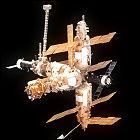 Russia launches Soyuz TM-29 to the Mir space station, carrying an international crew. Cosmonaut Viktor Afanasyev, French spationaut Jean-Pierre Haigneré, and Slovakian cosmonaut Ivan Bella are aboard. Afanasyev and Haigneré take up residence aboard Mir for 188 days, while Bella returns to Earth with Mir’s previous crew aboard Soyuz TM-28 after one week. When Afanasyev and Haigneré return to Earth in August 1999, they bring home cosmonaut Sergei Avdeyev, who by that point has served a full year in orbit aboard Mir. This is the last flight to Mir sponsored by the Russian government, which is now throwing its weight behind the International Space Station, and Mir is left unmanned when Soyuz TM-29 returns to Earth.
Russia launches Soyuz TM-29 to the Mir space station, carrying an international crew. Cosmonaut Viktor Afanasyev, French spationaut Jean-Pierre Haigneré, and Slovakian cosmonaut Ivan Bella are aboard. Afanasyev and Haigneré take up residence aboard Mir for 188 days, while Bella returns to Earth with Mir’s previous crew aboard Soyuz TM-28 after one week. When Afanasyev and Haigneré return to Earth in August 1999, they bring home cosmonaut Sergei Avdeyev, who by that point has served a full year in orbit aboard Mir. This is the last flight to Mir sponsored by the Russian government, which is now throwing its weight behind the International Space Station, and Mir is left unmanned when Soyuz TM-29 returns to Earth.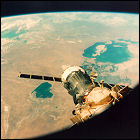 With help from the Russian space program, private corporation MirCorp launches Soyuz TM-30, the final spacecraft to visit the aging Mir space station. Sergei Zalyotin and veteran cosmonaut Aleksandr Kaleri become Mir’s first inhabitants in over eight months, and their mission is to begin refurbishing and repairing the 14-year-old station for what is hoped to be a series of commercial launches, including space tourism and even possibly a reality TV show set aboard Mir. What the two cosmonauts find, however, is that more work will be required than MirCorp can provide; after 72 days, the crew of Soyuz TM-30 returns to Earth, the money having run out before another crew can be sent. Mir will tumble out of its orbit and re-enter Earth’s atmosphere in 2001.
With help from the Russian space program, private corporation MirCorp launches Soyuz TM-30, the final spacecraft to visit the aging Mir space station. Sergei Zalyotin and veteran cosmonaut Aleksandr Kaleri become Mir’s first inhabitants in over eight months, and their mission is to begin refurbishing and repairing the 14-year-old station for what is hoped to be a series of commercial launches, including space tourism and even possibly a reality TV show set aboard Mir. What the two cosmonauts find, however, is that more work will be required than MirCorp can provide; after 72 days, the crew of Soyuz TM-30 returns to Earth, the money having run out before another crew can be sent. Mir will tumble out of its orbit and re-enter Earth’s atmosphere in 2001.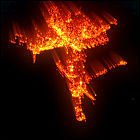 Despite attempts in recent years to keep the station in orbit for commercial purposes, the Russian space station Mir – originally launched in 1986 by the Soviet Union – is brought out of orbit with a deorbit burn fired by the engines of an attached unmanned Progress cargo vehicle. The largest space vehicle ever to plunge through Earth’s atmosphere, Mir breaks up over the south Pacific, where any surviving debris is expected to sink harmlessly into the ocean east of New Zealand. The fifteen-year-old station, having been designed with a service life of five years in mind, had been the site of the first joint Russian-American manned space operations since 1975, and led directly to both the contractual agreements and design of the International Space Station.
Despite attempts in recent years to keep the station in orbit for commercial purposes, the Russian space station Mir – originally launched in 1986 by the Soviet Union – is brought out of orbit with a deorbit burn fired by the engines of an attached unmanned Progress cargo vehicle. The largest space vehicle ever to plunge through Earth’s atmosphere, Mir breaks up over the south Pacific, where any surviving debris is expected to sink harmlessly into the ocean east of New Zealand. The fifteen-year-old station, having been designed with a service life of five years in mind, had been the site of the first joint Russian-American manned space operations since 1975, and led directly to both the contractual agreements and design of the International Space Station. The cosmonaut who still holds the record for the longest single stay in space, Dr. Valery Polyakov, dies at the age of 80. Born in 1942, Polyakov joined the cosmonaut corps in
The cosmonaut who still holds the record for the longest single stay in space, Dr. Valery Polyakov, dies at the age of 80. Born in 1942, Polyakov joined the cosmonaut corps in